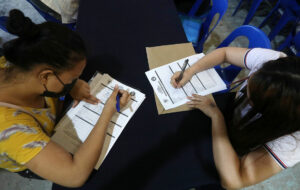By Justine Irish D. Tabile, Reporter
THE PHILIPPINES dropped six spots in an annual global ranking of countries’ ability to attract and retain a skilled workforce, a report by the Institute for Management Development (IMD) World Competitiveness Center showed.
In the IMD’s World Talent Ranking (WTR) 2023, the Philippines ranked 60th out of 64 countries, falling six places from 54th out of 63 economies last year.
The country’s talent competitiveness continued to lag other Asia-Pacific countries. It ranked 13th out of 14 Asia-Pacific countries, better only than Mongolia.
Singapore (8th overall) was the highest-ranking Asia-Pacific country, followed by Hong Kong (16th), Australia (18th), Taiwan (20th) and New Zealand (31st).
European countries dominated the talent index this year, with Switzerland, Luxembourg, Iceland, Belgium and the Netherlands in the top five.
The WTR rankings are based on three factors: “appeal” or the extent to which an economy attracts foreign and retains local talent, “investment and development” which refers to the measurement of resources allotted to develop a homegrown workforce, and “readiness” or the quality of the skills in a country’s talent pool.
José Caballero, a senior economist at IMD World Competitiveness Center, said in an e-mail interview that the drop in the Philippines’ talent ranking was due to the decline in the appeal and readiness factors.
“In terms of readiness, results indicate that the effectiveness of the talent pool to provide needed competencies has declined. For example, the Philippines’ performance in the indicators that capture the availability of senior managers with significant international experience and the availability of competent senior managers declined,” he said.
The Philippines’ readiness ranking slumped to 51st in the latest WTR, from 35th in 2022.
It also ranked 57th in terms of educational assessment with an average score of 350 in the Programme for International Student Assessment (PISA), a worldwide survey that measures 15-year-old students’ scholastic performance on mathematics, science and reading. To compare, China’s average PISA score is 579, while Singapore’s is 556.
However, the Philippines’ strengths were in labor force growth (ninth) and skilled labor (third).
The country also fell to 55th place in terms of appeal from 44th spot last year due to low scores in quality of life and brain drain.
“In terms of appeal, the country experienced a drop in the prioritization that the private sectors give to attracting and retaining talent which may have negatively affected the impact of brain drain on the competitiveness of the country,” Mr. Caballero said.
He also noted that executives’ perception about the quality of life in the Philippines declined, as pollution levels increased.
The WTR report also showed the Philippines remained at near bottom at 62nd place in terms of “investment and development.”
The Philippines ranked 63rd in terms of total public expenditure on education per student at $367. It was also one of the laggards in terms of pupil-teacher ratios for both primary (25.19) and secondary education (24.64), ranking 59th and 60th, respectively.
The country’s public expenditure on education stood at 3.1% of GDP (58th).
ING Bank N.V. Manila Senior Economist Nicholas Antonio T. Mapa said in a Viber message that he was disappointed that the country’s talent competitiveness ranking declined by six spots.
“One aspect that weighed on our ranking was investment and development with our sub-ranking the second lowest in Asia-Pacific,” he said.
IMD said in a statement that the results reflect the effect of the coronavirus pandemic on talent competitiveness worldwide.
“Most of the regions have not been able to return to the pre-pandemic levels of talent competitiveness,” it said.
Rizal Commercial Banking Corp. Chief Economist Michael L. Ricafort said the Philippines’ lower ranking could be attributed to the lost productivity, which was an effect of the prolonged lockdowns.
“Nearly 2.5 years of restrictions and some form of remote learning have adversely affected the poor most especially those that do not have access to internet, computers, and other gadgets used in remote learning,” he said in a Viber message.
“This caused some productivity losses and delays in the completion of schooling and delays in joining the workforce, thereby resulting in some foregoing income,” he said.
With the reopening of the economy, Mr. Ricafort said the country could still improve its competitiveness in terms of education and other productivity metrics.
“Increased government spending on infrastructure would also help boost competitiveness and productivity especially in addressing congestion and mobility issues in the economy,” he said.
IMD’s Mr. Caballero said the Philippines needs to boost the effectiveness of its education system if it wants to improve talent competitiveness.
“The aim should be the alignment between the demands for talent and its supply. For such an alignment, it is crucial that the public and private sectors closely cooperate in identifying the talent needs of the economy,” he said.
Mr. Caballero said companies should prioritize how to motivate their labor force by offering opportunities for upskilling and improving work-life balance.
Meanwhile, IMD said one of the major findings in the latest WTR report was that remote and hybrid work is affecting career progression.
Around 68% of the 4,000 executives surveyed believe that “in-office presence is important for career development.”
However, 27% said they felt that “remote work was detrimental to career development in their company.”
“These concerns arise, for example, from the possibility of a proximity bias among managers which can favor those individuals who follow the traditional in-office work model. If new work models lead to the curtailment of the opportunities that organizations offer to their staff, the organizations’ capacity to attract and retain talent may be limited. Such a trend can restrict talent development, and ultimately talent competitiveness,” IMD said.
